-
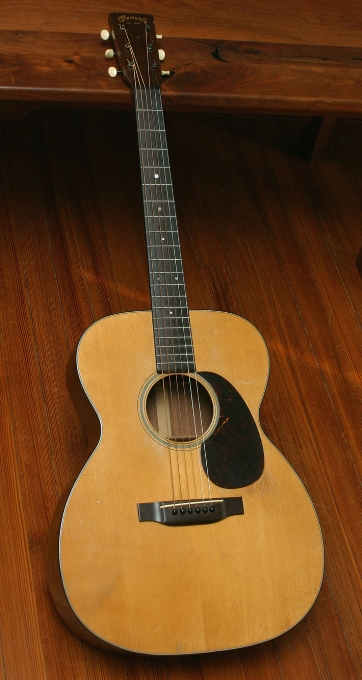 A rare, 100% original pre-war Martin. Not a crack anywhere. And though it of course has the 1-11/16 inch nut, it plays remarkably like the wider nut mid-30's 000-18's due to the generous (original) string spacing at the nut. Original finish. Neck has never been re-set. Original Ebony nut, ivory saddle, full height original bridge. Original tuners. Original plastic tuner buttons in great condition (no shrinkage). Lack of tuner ferrels of course (because of war-time metal shortages). Brazilian rosewood bridge, fingerboard, and peghead veneer. Scalloped braces. Original bridge plate. Frets show minor/normal wear. It shows light/normal pick wear around the soundhole (nothing anywhere near down to bare wood). Other minor superficial scratches on back, and sides. Bass tone and volume is impressive-the characteristic of war-time "pre-war" Martins, that featured more deeply scalloped braces. Many believe these more deeply scalloped braces found only in these years give them better tone than the mid-30s Martins. It does need a standard neck set. It's not egregiously out of set, action is a bit high at 12th fret. But due the originality of the instrument, original ivory saddle still hide glued-in, etc., we believe the buyer would want to set the neck to their liking. (We would be happy to set the neck for the new owner if desired, at no additional charge, after purchase.) The tone: gold standard pre-war 000-18. Loud, dark, crisp, and clear.
A rare, 100% original pre-war Martin. Not a crack anywhere. And though it of course has the 1-11/16 inch nut, it plays remarkably like the wider nut mid-30's 000-18's due to the generous (original) string spacing at the nut. Original finish. Neck has never been re-set. Original Ebony nut, ivory saddle, full height original bridge. Original tuners. Original plastic tuner buttons in great condition (no shrinkage). Lack of tuner ferrels of course (because of war-time metal shortages). Brazilian rosewood bridge, fingerboard, and peghead veneer. Scalloped braces. Original bridge plate. Frets show minor/normal wear. It shows light/normal pick wear around the soundhole (nothing anywhere near down to bare wood). Other minor superficial scratches on back, and sides. Bass tone and volume is impressive-the characteristic of war-time "pre-war" Martins, that featured more deeply scalloped braces. Many believe these more deeply scalloped braces found only in these years give them better tone than the mid-30s Martins. It does need a standard neck set. It's not egregiously out of set, action is a bit high at 12th fret. But due the originality of the instrument, original ivory saddle still hide glued-in, etc., we believe the buyer would want to set the neck to their liking. (We would be happy to set the neck for the new owner if desired, at no additional charge, after purchase.) The tone: gold standard pre-war 000-18. Loud, dark, crisp, and clear. -
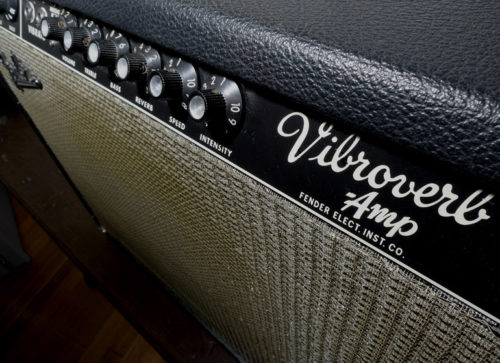 The blackface Vibroverb may be the most sought after Fender amp of all time. Stevie Ray Vaughan is famous for using them. The Vibroverb started as a 2x10 combo with reverb in '63. Then in late '63, Fender decided to switch to a 1x15. This amp has incredible tone. One must hear a black face circuit through an open cabinet JBL 15" speaker to understand the sound. It sounds big and can fill the hall, but it can work as a mid size amp perfect for gigs. This amp is versatile, since the JBL D130 can carry the treble of a telecaster or strat while still having a strong bottom end. Most other amps are either good on highs (Vibrolux, Princeton, Champ), good on lows (Twin, Showman), midrangy (Deluxe, and most new amps) or too big (Marshall double stack). The great Vibroverb is superior to them all. This 1964 Blackface Vibroverb has the original JBL speaker, and the original transformer. The amp also comes with its original footswitch. The only thing done to the amp has been replaced tubes, and the caps. The power cord has been replaced with a grounded three-prong cord.
The blackface Vibroverb may be the most sought after Fender amp of all time. Stevie Ray Vaughan is famous for using them. The Vibroverb started as a 2x10 combo with reverb in '63. Then in late '63, Fender decided to switch to a 1x15. This amp has incredible tone. One must hear a black face circuit through an open cabinet JBL 15" speaker to understand the sound. It sounds big and can fill the hall, but it can work as a mid size amp perfect for gigs. This amp is versatile, since the JBL D130 can carry the treble of a telecaster or strat while still having a strong bottom end. Most other amps are either good on highs (Vibrolux, Princeton, Champ), good on lows (Twin, Showman), midrangy (Deluxe, and most new amps) or too big (Marshall double stack). The great Vibroverb is superior to them all. This 1964 Blackface Vibroverb has the original JBL speaker, and the original transformer. The amp also comes with its original footswitch. The only thing done to the amp has been replaced tubes, and the caps. The power cord has been replaced with a grounded three-prong cord. -
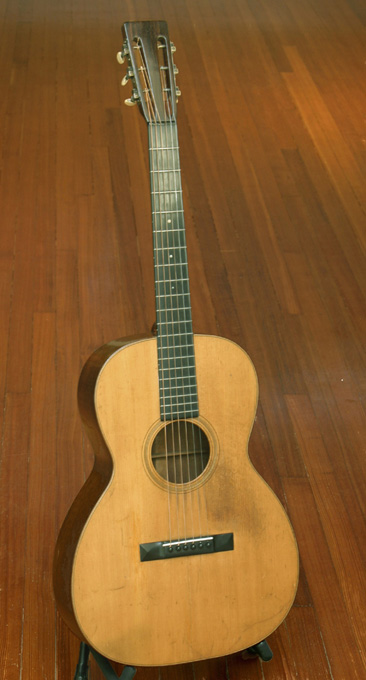 Take Martin’s best era for 12-fret guitars, add more scale length, and you get the best of both worlds–that’s what players say about the 000 sized 12-frets, if they can find one, from the mid to late 20’s. This was the biggest, loudest Martin made for steel strings in this era, with a 25.4 inch scale length, the same scale length as a 30’s D-45! (The 14-fret 000’s of the 30s and later have a shorter, 24.5 inch scale). In no other instrument will you get the resonance (from thin tops and back), combined with the long scale length. It’s a big pre-war Martin 12-fret. That’s why this instrument is a highly sought-after prewar Martin. This crack-free 000-18 has great provenance: acquired from and set up by one of the world’s top Martin experts (in Tuebingen, Germany). 1 7/8” nut. Mahogany back and sides. Adirondack spruce top. Ebony fingerboard. It has original tuners (gear wheel below worm gear, ivoroid buttons), parts, and all original finish. Restoration by TJ Thompson and Dana Bourgeois: correct replacement bridge (ebony pyramid) and bridge plate (maple), and frets replaced (bar frets). Center seam repaired and cleated and touched up (shellack). Neck has been reset. Neck is dead straight, bridge saddle is medium height (allows set up for both higher and lower action if needed in future). Low action, and set up for light or medium gauge strings. The tone could not be better: all the clear separation of the mids that is the hallmark of the 20’s style 18 twelve-fret, but with fuller, louder, rounder bass. One of the most sought-after Martin 12-frets, original finish, crack-free. Restored correctly, cared for, and set up by the world’s best luthiers and vintage Martin experts, and ready to enjoy.
Take Martin’s best era for 12-fret guitars, add more scale length, and you get the best of both worlds–that’s what players say about the 000 sized 12-frets, if they can find one, from the mid to late 20’s. This was the biggest, loudest Martin made for steel strings in this era, with a 25.4 inch scale length, the same scale length as a 30’s D-45! (The 14-fret 000’s of the 30s and later have a shorter, 24.5 inch scale). In no other instrument will you get the resonance (from thin tops and back), combined with the long scale length. It’s a big pre-war Martin 12-fret. That’s why this instrument is a highly sought-after prewar Martin. This crack-free 000-18 has great provenance: acquired from and set up by one of the world’s top Martin experts (in Tuebingen, Germany). 1 7/8” nut. Mahogany back and sides. Adirondack spruce top. Ebony fingerboard. It has original tuners (gear wheel below worm gear, ivoroid buttons), parts, and all original finish. Restoration by TJ Thompson and Dana Bourgeois: correct replacement bridge (ebony pyramid) and bridge plate (maple), and frets replaced (bar frets). Center seam repaired and cleated and touched up (shellack). Neck has been reset. Neck is dead straight, bridge saddle is medium height (allows set up for both higher and lower action if needed in future). Low action, and set up for light or medium gauge strings. The tone could not be better: all the clear separation of the mids that is the hallmark of the 20’s style 18 twelve-fret, but with fuller, louder, rounder bass. One of the most sought-after Martin 12-frets, original finish, crack-free. Restored correctly, cared for, and set up by the world’s best luthiers and vintage Martin experts, and ready to enjoy. -
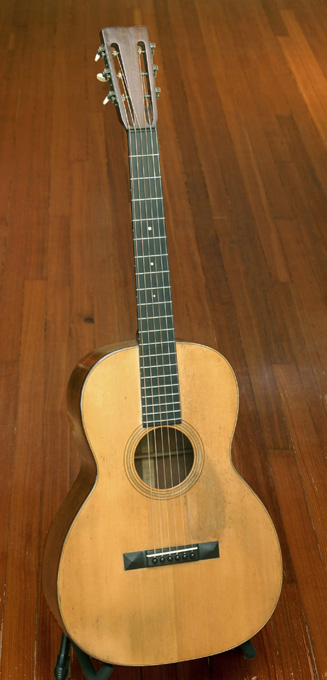 A steel-string braced 00-18, with finely scalloped braces, and light as a feather. No wonder the tone is exquisite. This 12-fret gem, from the best era for Martin12-frets, resonates in your hands (say what you want about the 30’s, but the more lightly-built Martins of the 20’s become an extension of your body). The set up is low (4 to 5 64ths), so it plays like a dream. Original finish throughout. Mahogany back and sides. Adirondack spruce top. Ebony fingerboard. Original tuners/gear wheel below worm gear, ivoroid buttons. The instrument was acquired from one of North America’s top Martin restoration shops, Folkway Music, who reported: “This 00-18 went back to Martin in the late 80's for a neck reset, refret, re-bridge, and a new bridge plate. The back has one repaired crack, and there are two well repaired side cracks. Martin's repairs are well done, the new bar frets are nice and tall, and the bridge plate (maple) is only slightly oversized. The somewhat oversized pyramid bridge didn't look great when the guitar came in, so we re-profiled it here in shop and fitted a new bone saddle and vintage-correct bridge-pins.” This instrument will not disappoint. It has been correctly and meticulously restored by Martin, and by one of the world’s top Martin experts. It’s ready for decades of enjoyment.
A steel-string braced 00-18, with finely scalloped braces, and light as a feather. No wonder the tone is exquisite. This 12-fret gem, from the best era for Martin12-frets, resonates in your hands (say what you want about the 30’s, but the more lightly-built Martins of the 20’s become an extension of your body). The set up is low (4 to 5 64ths), so it plays like a dream. Original finish throughout. Mahogany back and sides. Adirondack spruce top. Ebony fingerboard. Original tuners/gear wheel below worm gear, ivoroid buttons. The instrument was acquired from one of North America’s top Martin restoration shops, Folkway Music, who reported: “This 00-18 went back to Martin in the late 80's for a neck reset, refret, re-bridge, and a new bridge plate. The back has one repaired crack, and there are two well repaired side cracks. Martin's repairs are well done, the new bar frets are nice and tall, and the bridge plate (maple) is only slightly oversized. The somewhat oversized pyramid bridge didn't look great when the guitar came in, so we re-profiled it here in shop and fitted a new bone saddle and vintage-correct bridge-pins.” This instrument will not disappoint. It has been correctly and meticulously restored by Martin, and by one of the world’s top Martin experts. It’s ready for decades of enjoyment. -
 100% crack-free, structurally perfect, this 00-28 is gold standard for 12 fret, pre-war Martin Brazilian Rosewood tone. Refinished to exquisite standards some 40 years ago, this 00-28 has some of the most stunning Brazilian rosewood ever used by Martin. This is the most beautiful, best sounding "Herringbone" prewar 00-28 we've seen. And with mileage on the finish, at the Arlington Guitar Show last fall, several top vintage guitar dealers were not sure if this wasn't the original finish on the guitar, it's that good. It is braced for steel strings. It has held steel strings for years, and not only are there no cracks or stress issues, there is no bellying behind the bridge. And if that’s not enough, there is a letter from Mike Longworth, signed by Longworth and dated 1984, documenting the guitar, and suggesting the use of steel strings on it. Condition:
100% crack-free, structurally perfect, this 00-28 is gold standard for 12 fret, pre-war Martin Brazilian Rosewood tone. Refinished to exquisite standards some 40 years ago, this 00-28 has some of the most stunning Brazilian rosewood ever used by Martin. This is the most beautiful, best sounding "Herringbone" prewar 00-28 we've seen. And with mileage on the finish, at the Arlington Guitar Show last fall, several top vintage guitar dealers were not sure if this wasn't the original finish on the guitar, it's that good. It is braced for steel strings. It has held steel strings for years, and not only are there no cracks or stress issues, there is no bellying behind the bridge. And if that’s not enough, there is a letter from Mike Longworth, signed by Longworth and dated 1984, documenting the guitar, and suggesting the use of steel strings on it. Condition:- No cracks anywhere.... Not a hint of a crack
- original bridge plate, in great condition
- original tuners
- original ivory bridge pins (the replacement bridge was made to accommodate these great original ivory bridge pins)
- Bridge is a perfect Brazilian Rosewood replacement, done by us, with old growth Brazilian.
- Saddle, and nut, carved from ivory (sourced by us, pre-CITES)
- Three very tiny screw holes above endpin from a previous tailpiece added and removed decades ago, were expertly filled by Tony Nobles–difficult to see more than a few inches away
- All the bar frets replaced by us (with Bar fret material from TJ Thomson), so it plays like a dream, with that full, cascading Brazilian tone that you'll only get from a fine 00-28
-
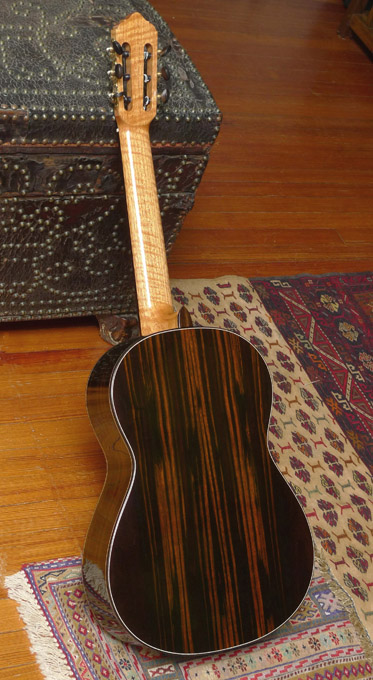 Vustom made Lester Devoe Flamenco Negra, a one-of-a-kind, Brazilian Rosewood guitar, from one of the world’s top luthiers. Lester Devoe needs no introduction to the world’s great Flamenco players. The late, legendary Sabicas played a Devoe– and converted some of the great Flamenco players in Spain to the fold. Paco De Lucia, and Vicente Amigo, among others, play Devoe Flamenco guitars. (I personally delivered a Devoe Flamenco Blanca guitar to Paco De Lucia in Spain in late 2010– Paco likes his Devoe’s hand-delivered. Paco De Lucia began playing a Devoe Negra guitar years ago– and there are many Paco De Lucia recordings and feature films where Paco plays a Devoe Flamenco guitar.) And it’s rare that Lester makes a Negra with Brazilian rosewood of this age and quality.
Vustom made Lester Devoe Flamenco Negra, a one-of-a-kind, Brazilian Rosewood guitar, from one of the world’s top luthiers. Lester Devoe needs no introduction to the world’s great Flamenco players. The late, legendary Sabicas played a Devoe– and converted some of the great Flamenco players in Spain to the fold. Paco De Lucia, and Vicente Amigo, among others, play Devoe Flamenco guitars. (I personally delivered a Devoe Flamenco Blanca guitar to Paco De Lucia in Spain in late 2010– Paco likes his Devoe’s hand-delivered. Paco De Lucia began playing a Devoe Negra guitar years ago– and there are many Paco De Lucia recordings and feature films where Paco plays a Devoe Flamenco guitar.) And it’s rare that Lester makes a Negra with Brazilian rosewood of this age and quality.- 650mm scale length
- Nut: 52mm
- Neck width at nut: 52mm
- String Spacing at nut: 44mm
- 80 year old Brazilian Rosewood (pre-CITES) back and sides (Quartersawn).
- European spruce top, with some beautiful and understated “"hazelfichte" (what Americans call bear claw).
- Custom, flamed Spanish Cedar neck
- Brazilian Rosewood headstock overlay, and bridge
- Brazilian Rosewood body binding, top and back
- Ebony fingerboard
- Sloane tuners
- Austere yet elegant Santos style black and white rosette, that Devoe uses only rarely, on top custom models
- Nitrocellulose lacquer finish
-
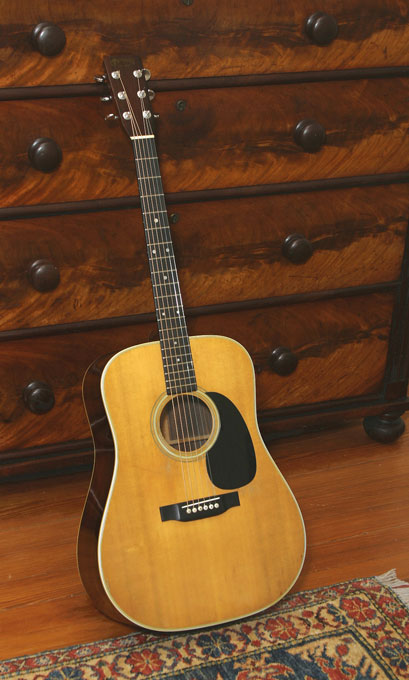 The last of the Mohicans, made within a few months before Martin stopped using Brazilian Rosewood on its instruments. Some guitars feel dead right the minute you pick them up. This is on of those. First and foremost, the tone of this instrument is unsurpassed for the bell-like trebles that only come from Brazilian Rosewood. The tone of this guitar, I would hold up to most mid-40’s D-28’s I’ve played. Playability, and set-up: it could not be better, and it’s got that 60’s combination of low action, great tuning speed and accuracy from the Grovers, and superb intonation all the way to the wee frets. More than anything, this guitar stands out for its low action combined with robust tone. Amazingly, the string height at the 12th fret: Just a hair over 2/32” at the high E; and 3/32 at the low E. It plays in our left hand like a dream, fast and fluid… yet the tone is full with no buzzing anywhere. I personally have never played a Martin dreadnought from any period that is so effortless to play, so easy on the left hand and so fast and yet so full of Brazilian tone. BTW, light gauge strings only? No way… I’ve got it strung with medium gauge, and it plays like butter in your left hand. Condition:
The last of the Mohicans, made within a few months before Martin stopped using Brazilian Rosewood on its instruments. Some guitars feel dead right the minute you pick them up. This is on of those. First and foremost, the tone of this instrument is unsurpassed for the bell-like trebles that only come from Brazilian Rosewood. The tone of this guitar, I would hold up to most mid-40’s D-28’s I’ve played. Playability, and set-up: it could not be better, and it’s got that 60’s combination of low action, great tuning speed and accuracy from the Grovers, and superb intonation all the way to the wee frets. More than anything, this guitar stands out for its low action combined with robust tone. Amazingly, the string height at the 12th fret: Just a hair over 2/32” at the high E; and 3/32 at the low E. It plays in our left hand like a dream, fast and fluid… yet the tone is full with no buzzing anywhere. I personally have never played a Martin dreadnought from any period that is so effortless to play, so easy on the left hand and so fast and yet so full of Brazilian tone. BTW, light gauge strings only? No way… I’ve got it strung with medium gauge, and it plays like butter in your left hand. Condition:- all original: finish; frets bridge, bridge plate, saddle. (Bridge pins could be replacements, hard to tell, but they are right.)
- The bridge looks like it has never been off
- Neck has never been set
- There is minor pickwear, with some moderate wear around the soundhole.
- No cracks on top; two, almost indiscernible cracks on back, that have been addressed–glued (no cleats). You have to look very hard to see these two back cracks, they are hairline cracks, each about 6 inches long.. but they are not visible from more than a few inches away, and impossible to photograph.
- Minor nicks and dings, most are visible in photos
- No strap lugs ever added
- Original end pin
- Throw away the book on this one… This is one of the best Brazilian rosewood Dreadnought Martins you’ll play, period, in fine original condition.
-
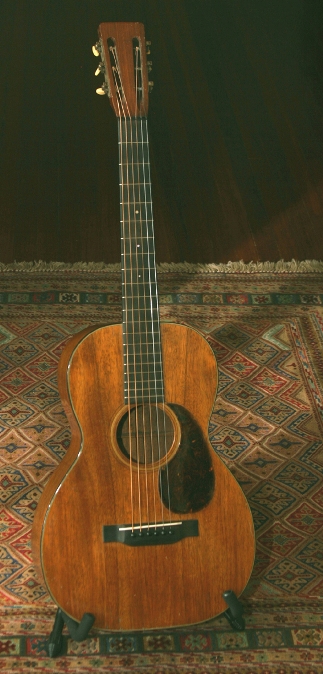 We converted this Golden Era 12-fret Koa Martin from the original Hawaiian setup ourselves, so it's perfect. The instrument does not have a crack anywhere. All original finish. Original Ebony bridge, converted from the tall Hawaiian set-up to a normal 30's set-up. Same with the ebony nut. All new, period-perfect Bar Frets. We radiused the ebony fretboard to 30's Martin specs. Neck was set and action is perfect. 1-7/8 inch nut width. Original tuners. Original bridge plate. Minor nicks and dings on top and back, but with the all original finish and crack-free, it's a rare specimen. Nothing compares in tone to an all-Koa Golden Age Martin. Koa blends the midrange of mahogany with the top end of maple-or, in the case of a fine 30's Koa Martin- hints of Brazilian rosewood. This fine 0-18K has all you would want from a Koa Martin, with the clearest, bell-like treble string tone imaginable.
We converted this Golden Era 12-fret Koa Martin from the original Hawaiian setup ourselves, so it's perfect. The instrument does not have a crack anywhere. All original finish. Original Ebony bridge, converted from the tall Hawaiian set-up to a normal 30's set-up. Same with the ebony nut. All new, period-perfect Bar Frets. We radiused the ebony fretboard to 30's Martin specs. Neck was set and action is perfect. 1-7/8 inch nut width. Original tuners. Original bridge plate. Minor nicks and dings on top and back, but with the all original finish and crack-free, it's a rare specimen. Nothing compares in tone to an all-Koa Golden Age Martin. Koa blends the midrange of mahogany with the top end of maple-or, in the case of a fine 30's Koa Martin- hints of Brazilian rosewood. This fine 0-18K has all you would want from a Koa Martin, with the clearest, bell-like treble string tone imaginable. -
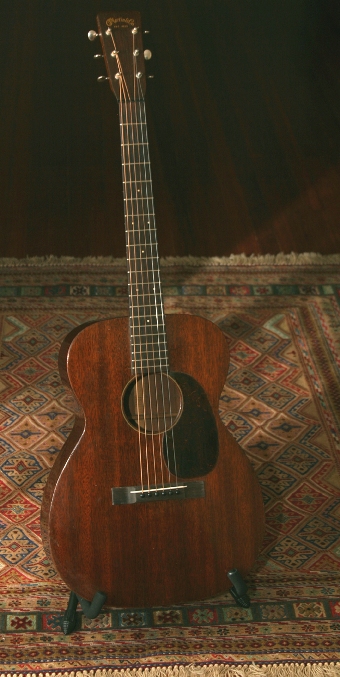 This model is something of a sleeper on the Golden Era Martin guitar market, because there are just not that many pre-1939 00-17s available. There are quite a few war-time and post-war 00-17s, but a 00-17 with full pre-war specs, forward shifted X-bracing, and 1 3/4 inch nut, is hard to come by–and they have all the great qualities of 00-sized Golden Era Martins that cost twice or three times the price on the vintage market–for now, as these great pre-war 00-17s will catch up quickly. The tone and volume of this 00-17 is astounding: full, amazingly bright, and with impressive volume. 1-3/4 inch nut width. Crack-free except for a well-repaired crack on bass side, about 2 inches long, that's difficult to see even up close. No cracks at all on top, or back. All original finish. Original bridge plate. This model has of course a mahogany top as well as mahogany back and sides. And with that dark look and original gloss finish that really sets this Golden Age Martin apart in its own class. Neck has the typically slightly beefier profile that's the hallmark of the best 30's 14-fret Martins. Neck was set by us. Replaced, period-correct Brazilian rosewood bridge. Original ebony nut. All new T-frets installed by us. Original tuners.
This model is something of a sleeper on the Golden Era Martin guitar market, because there are just not that many pre-1939 00-17s available. There are quite a few war-time and post-war 00-17s, but a 00-17 with full pre-war specs, forward shifted X-bracing, and 1 3/4 inch nut, is hard to come by–and they have all the great qualities of 00-sized Golden Era Martins that cost twice or three times the price on the vintage market–for now, as these great pre-war 00-17s will catch up quickly. The tone and volume of this 00-17 is astounding: full, amazingly bright, and with impressive volume. 1-3/4 inch nut width. Crack-free except for a well-repaired crack on bass side, about 2 inches long, that's difficult to see even up close. No cracks at all on top, or back. All original finish. Original bridge plate. This model has of course a mahogany top as well as mahogany back and sides. And with that dark look and original gloss finish that really sets this Golden Age Martin apart in its own class. Neck has the typically slightly beefier profile that's the hallmark of the best 30's 14-fret Martins. Neck was set by us. Replaced, period-correct Brazilian rosewood bridge. Original ebony nut. All new T-frets installed by us. Original tuners. -
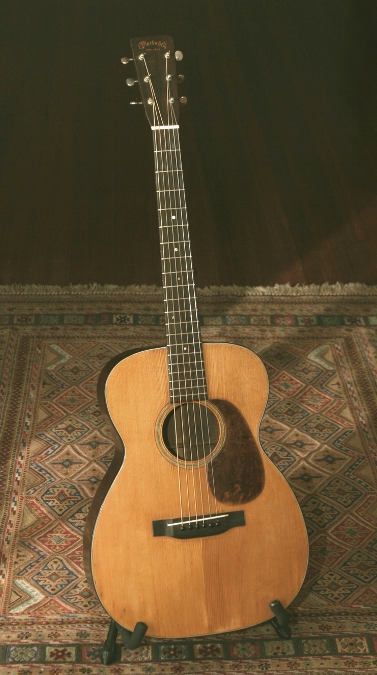 Probably the best year ever for 14-fret 00-18s. In the Golden Age of 14-fret Martins from the early 30's until the late 30's, only in 1936 did Martin use Brazilian rosewood (as opposed to ebony) for the fretboard and bridges of 18's, so its tone is considered by many to be the best in the 14 fret, 1-3/4 inch nut era. The guitar is crack-free on the top and back. Just one repaired crack on the treble side.The repair is well done and almost impossible to see from the outside (older repair has muslin cloth on inside-luthiers agree that these older cloth patches inside a vintage Martin should be left in place). Original tuners. Original bridge plate. Original nut. Replaced T-frets by us. Replacement bridge-very dark Brazilian rosewood bridge made to original specs in our shop, and ivory saddle. The neck has that wonderful mid-thirties slightly fatter profile. Neck set by us. And the tone is the best example of a Golden Era 00-18 you'll find anywhere. Light overspray (no refinishing) on back and sides (not top, neck or head).
Probably the best year ever for 14-fret 00-18s. In the Golden Age of 14-fret Martins from the early 30's until the late 30's, only in 1936 did Martin use Brazilian rosewood (as opposed to ebony) for the fretboard and bridges of 18's, so its tone is considered by many to be the best in the 14 fret, 1-3/4 inch nut era. The guitar is crack-free on the top and back. Just one repaired crack on the treble side.The repair is well done and almost impossible to see from the outside (older repair has muslin cloth on inside-luthiers agree that these older cloth patches inside a vintage Martin should be left in place). Original tuners. Original bridge plate. Original nut. Replaced T-frets by us. Replacement bridge-very dark Brazilian rosewood bridge made to original specs in our shop, and ivory saddle. The neck has that wonderful mid-thirties slightly fatter profile. Neck set by us. And the tone is the best example of a Golden Era 00-18 you'll find anywhere. Light overspray (no refinishing) on back and sides (not top, neck or head). -
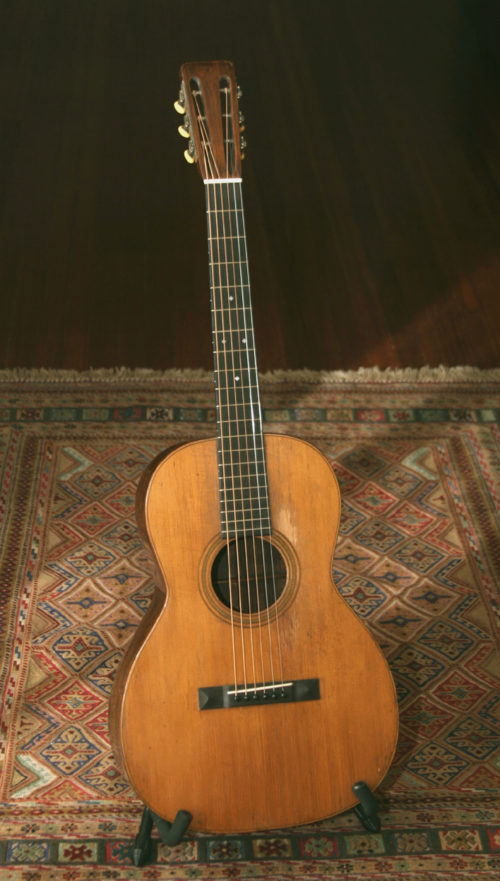 This big 12-fret Brazilian Rosewood pre-war Martin is properly set up for steel strings, with new replacement ebony pyramid bridge meticulously made to original specs, but compensated for steel string, perfect intonation. All braces original and in great shape. Original bridge plate. All original finish everywhere. This guitar has all the tone you'd expect from a pre-war 00 Brazilian Martin. It's had restoration work, all by us, recently, as follows. Hide glue used in all repairs/restoration.
This big 12-fret Brazilian Rosewood pre-war Martin is properly set up for steel strings, with new replacement ebony pyramid bridge meticulously made to original specs, but compensated for steel string, perfect intonation. All braces original and in great shape. Original bridge plate. All original finish everywhere. This guitar has all the tone you'd expect from a pre-war 00 Brazilian Martin. It's had restoration work, all by us, recently, as follows. Hide glue used in all repairs/restoration.- Several cracks in sides, back, and top professionally repaired (5 or 6 cracks overall)
- Small hole drilled in top of headstock many decades ago (to hang the guitar on a wall presumably) has been expertly filled and finished with a piece of Brazilian rosewood veneer, on front, to match the veneer of the headstock.
- Neck set.
- New replacement ebony pyramid bridge meticulously made to original specs, but compensated to steel string intonation. Scratch marks in spruce top, on either side of bridge, filled and finished.
- All new, replacement Bar Frets
- To the thin maple, original bridge plate, we carefully added tiny maple ring/plugs, with hide glue, into the holes, to address bridge pins holes slightly enlarged over the years.
- Older repaired small crack in heel expertly touched up. It's 100% stable. (It appears to be a surface/finish crack.) It's very hard to see even up close, and impossible to photograph.
-
 The instrument features the original ebony bridge (full height), original tuners, original ivory saddle and nut, original maple bridge plate. Ebony fretboard. Bar frets. Thin, Soft-V neck. Finish is original. There is some overspray on the top, which is confined mainly to below the soundhole (over about the same size area, as what a pickguard would cover–but it never had a pickguard), and a bit below the bridge, and very very light on other areas of the top. Apparently a previous owner wanted to address the pick/finger wear and a repaired crack below the bridge. It's generally unobtrusive, no effect on the color of the top, and not noticeable from a few feet. Also, some light overspray on back and sides. As overspray goes, it has minimal effect on the appearance. Neck, and head have no overspray at all. There is one crack on the instrument from the bridge to the bottom of the guitar, but it's well repaired (it's about a half-inch from the center seam, below the bridge). Also about a 2 1/2 inch shallow crack/finish crack near where the fretboard meets the top (about 1/8 inch from the fretboard), on low-E side (does not go through–It is not visible on underside of top). There is a small indentation on the side rosewood (about one inch in area, on the side/lower, stable.) 1-7/8 inch nut. Action is 3/32 inch high E string/12th fret. 4/32 low E string… just right to get that full, cascading Brazilian tone from this fine 0-21.
The instrument features the original ebony bridge (full height), original tuners, original ivory saddle and nut, original maple bridge plate. Ebony fretboard. Bar frets. Thin, Soft-V neck. Finish is original. There is some overspray on the top, which is confined mainly to below the soundhole (over about the same size area, as what a pickguard would cover–but it never had a pickguard), and a bit below the bridge, and very very light on other areas of the top. Apparently a previous owner wanted to address the pick/finger wear and a repaired crack below the bridge. It's generally unobtrusive, no effect on the color of the top, and not noticeable from a few feet. Also, some light overspray on back and sides. As overspray goes, it has minimal effect on the appearance. Neck, and head have no overspray at all. There is one crack on the instrument from the bridge to the bottom of the guitar, but it's well repaired (it's about a half-inch from the center seam, below the bridge). Also about a 2 1/2 inch shallow crack/finish crack near where the fretboard meets the top (about 1/8 inch from the fretboard), on low-E side (does not go through–It is not visible on underside of top). There is a small indentation on the side rosewood (about one inch in area, on the side/lower, stable.) 1-7/8 inch nut. Action is 3/32 inch high E string/12th fret. 4/32 low E string… just right to get that full, cascading Brazilian tone from this fine 0-21.